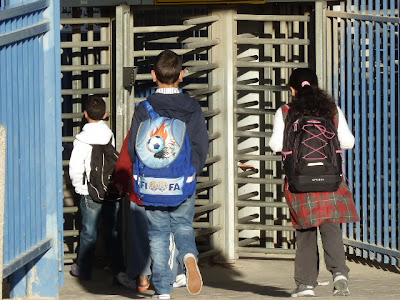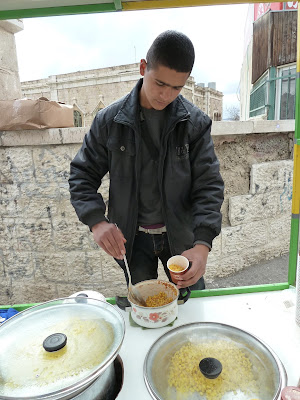 |
| Ofer army base, prison, and court |
It is hard for international observers to get into an Israeli military court, but it is even harder for a Palestinian detainee to get out of one. Fellow EA Olli from Finland and I joined a dozen other international observers to attend a hearing today in Ofer, which is a huge army base, prison, and court near Ramallah.
We were following the case of Hassan Karajah, the youth coordinator of the Stop the Wall Movement, who was arrested at 2:30 a.m. on January 23 in his home in the village of Saffa, near Ramallah. He was not allowed to see his lawyer for the first 20 days. He has been held in solitary confinement in a windowless 6x6 foot cell, and the only time he sees the sun--or family--is when he is taken to court hearings. He is being held in a prison inside Israel, which is illegal under international humanitarian law.
 |
| Hassan Karajah (Photo by Palestine Monitor) |
His 10-minute hearing today in a packed, trailer-like military court, was chaotic and farcical. The young military prosecutor said little, and the elderly military judge mainly shuffled papers. He drew a firm denial from Hassan when he suggested that the detainee has links to Hezbollah, the Lebanese-based Islamic militant group.
At the end of the hearing, the judge ordered Hassan held for an additional seven days to allow the prosecution time to prepare charges. His lawyer, Mahmoud Hassan, told us that when formal charges are filed, he will be able to request a copy of the evidence, which so far has been secret. The good news for the detainee is that his interrogation phase is over. He has reportedly been questioned over and over for up to 14 hours a day, shackled to a chair. The attorney said he may be able to request bail after the charges are filed.
Hassan's odds for acquittal under Israeli military "justice" are exceedingly slim. Official military court statistics report the rate of convictions is more than 99%! The Adameer human rights organization says most defendants accept a plea bargain for a shorter sentence.
Hassan's seat on the defendants' box in the cramped court was only about six feet from his mother Hanan, and he was allowed to chat with her during the proceedings, which he may have tuned out because they were all in Hebrew. A soldier assigned to translate seemed to provide only sporadic explanations. Hassan's fiance Sundos was also there, but not close enough to chat. They were the only two family members permitted to attend the hearing, besides his brother Muhannad, an attorney who is part of his legal defense team.
 |
| First cage door to military court security |
 |
| Family members waiting in the cage outside court security |
It took us an hour and a half to get through the disorganized security process to enter the court. When we first got a guard's attention, he said, "Are you on the list?" When we replied affirmatively, he said, "Wait five minutes." After 30 minutes, we called the official who had approved the list. He said, "Give me five minutes." After 30 more minutes we were admitted through the first cage door to surrender our passports (with some trepidation) to the Israeli Prison Service and to get a key to a locker. There we deposited everything except the blank notebook, pen, and money for snacks that we were permitted to bring in the compound. We went back through the same door to a metal detector, which beeped even after we took out everything from our pockets. We then went through a turnstile to wait outside a blue solid steel door to be called individually for the next phase. Inside, I took everything out of my pockets for the second time, removed belt and boots, and got through the second metal detector without beeping. After I put on my belt and boots, I was sent to a closed room where I took everything out of my pockets for the third time and was given a very intrusive private "wanding," then released to follow the caged path to a courtyard where there is a comfortable waiting area with food service and toilets, right across from the six trailer-like courtrooms. Families and observers never know when their case will be called. They just have to wait. Sundos told me that one of the previous hearings was moved to a location where they were not permitted to attend at all.
If the Israeli Prison Service gives such a hard time to court visitors, I shudder to think how they may be treating the prisoners.



















































